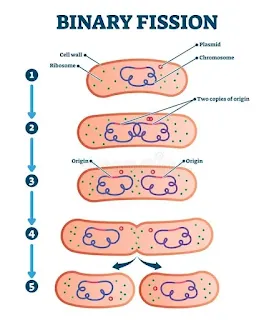Reproduction and Microbial Growth of Microorganisms
Microorganisms—including bacteria, fungi, viruses, protozoa, and algae—comprise a vast and diverse group of life forms whose small size conceals their immense biological significance. These microscopic entities play pivotal roles in ecosystems, human health, and technological innovation. Their remarkable capacities for rapid reproduction and adaptive growth are fundamental to medicine, agriculture, environmental management, and industrial biotechnology. A deep understanding of microbial reproduction and growth is crucial for driving advancements across these fields.
Mechanisms of Microbial Reproduction
Microorganisms reproduce through a variety of mechanisms tailored to their biological characteristics and environmental conditions. These strategies are primarily classified as asexual or sexual, each offering distinct advantages for survival and adaptation.
1. Binary Fission: The Principal Asexual Method in Bacteria
Binary fission is the dominant form of reproduction in bacteria, enabling rapid population expansion.
Process:
-
The bacterial cell elongates as it replicates its circular DNA molecule.
-
DNA copies attach to the plasma membrane at separate sites.
-
A septum forms, partitioning the cytoplasm.
-
The cell divides into two genetically identical daughter cells.
Example:
-
Escherichia coli can divide approximately every 20 minutes under optimal laboratory conditions.
2. Budding: An Alternative Asexual Strategy
Budding occurs in some yeasts and bacteria, representing a distinctive mode of reproduction.
Process:
-
A small protrusion (bud) forms on the parent cell.
-
Mitosis divides the nucleus, and one daughter nucleus enters the bud.
-
The bud enlarges and detaches to become an independent organism.
Example:
-
Saccharomyces cerevisiae (baker’s yeast) reproduces through budding, critical to bread and alcohol production.
3. Spore Formation: A Survival and Reproductive Mechanism
Spore formation enables microorganisms to survive extreme conditions and disseminate.
Bacterial Endospores:
-
Formed by Bacillus and Clostridium species.
-
Endospores are highly resistant to heat, desiccation, chemicals, and UV radiation.
-
They germinate into active cells when conditions improve.
Fungal Spores:
-
Fungi such as Aspergillus and Penicillium generate spores.
-
These may form sexually (e.g., zygospores) or asexually (e.g., conidia).
4. Sexual Reproduction: Enhancing Genetic Diversity
Sexual reproduction fosters genetic variation, increasing the evolutionary fitness of microbial populations.
Process:
-
Two cells exchange or combine genetic material through processes like conjugation or syngamy.
-
The offspring possess a novel genetic composition.
Example:
-
Paramecium undergoes conjugation, exchanging micronuclear DNA to enhance genetic diversity.
Microbial Growth Dynamics
Microbial growth refers to an increase in cell numbers and follows a characteristic growth curve comprising four distinct phases.
1. Lag Phase
-
Microorganisms adjust to new environmental conditions.
-
High metabolic activity occurs without immediate cell division.
-
Duration varies depending on the organism and medium.
2. Exponential (Log) Phase
-
Cells divide at a maximum and constant rate.
-
Population size doubles at regular intervals.
-
Ideal for studies requiring active metabolism and replication.
Example:
-
E. coli can double every 20 minutes under ideal conditions.
3. Stationary Phase
-
Nutrient depletion and waste accumulation slow growth.
-
Cell division and death rates equilibrate.
-
Secondary metabolites such as antibiotics are often produced.
4. Death (Decline) Phase
-
Accumulating toxic byproducts and nutrient scarcity cause cell death.
-
Some organisms form resistant structures like spores to endure adverse conditions.
Environmental Factors Affecting Microbial Growth
Microbial proliferation and survival are profoundly influenced by environmental variables.
1. Nutrient Availability
-
Essential macronutrients: carbon, nitrogen, phosphorus, sulphur.
-
Micronutrients and growth factors are vital for fastidious organisms.
2. Temperature Preferences
-
Psychrophiles: Optimal growth between -20°C and 10°C.
-
Mesophiles: Optimal range of 20°C to 45°C (e.g., human pathogens).
-
Thermophiles: Grow best between 45°C and 80°C.
-
Hyperthermophiles: Thrive above 80°C.
3. pH Preferences
-
Acidophiles: Optimal growth at pH 0-5.
-
Neutrophiles: Prefer pH 6-8.
-
Alkaliphiles: Grow best at pH 9-11.
4. Oxygen Requirements
-
Obligate Aerobes: Require oxygen.
-
Obligate Anaerobes: Killed by oxygen.
-
Facultative Anaerobes: Grow with or without oxygen.
-
Microaerophiles: Need low oxygen levels.
5. Water Activity (Aw)
-
Essential for enzymatic and cellular activities.
-
Halophiles: Adapted to high-salt environments.
Applications of Microbial Growth and Reproduction Knowledge
Understanding microbial growth and reproduction is vital to multiple scientific and industrial disciplines.
1. Medical Microbiology
-
Informs antibiotic development and vaccine production.
-
Aids in disease prevention and control.
2. Food Industry
-
Exploits microbial fermentation in the production of dairy, bakery, and alcoholic products.
-
Enhances food preservation strategies.
3. Biotechnology
-
Microbial systems produce enzymes, pharmaceuticals, and biofuels.
-
Engineered microbes drive advances in synthetic biology.
4. Environmental Microbiology
-
Bioremediation uses microbes to degrade environmental pollutants.
-
Supports restoration of contaminated sites.
5. Agricultural Microbiology
-
Microbial inoculants improve soil fertility and plant health.
-
Biopesticides offer sustainable pest management solutions.
Conclusion
Microorganisms, through diverse reproductive and growth strategies, exhibit remarkable adaptability and resilience, ensuring their dominance in nearly every habitat on Earth. Binary fission, budding, spore formation, and sexual reproduction underpin their survival and evolutionary success. Environmental factors—nutrients, temperature, pH, oxygen availability, and water activity—govern microbial growth patterns, providing opportunities for targeted application in health care, industry, environmental science, and agriculture. Mastery of microbial life processes continues to offer profound benefits for science, society, and the environment.
Note: Image source Google
References
-
Madigan, M.T., Bender, K.S., Buckley, D.H., Sattley, W.M., & Stahl, D.A. (2018). Brock Biology of Microorganisms (15th ed.). Pearson.
-
Prescott, L.M., Harley, J.P., & Klein, D.A. (2017). Microbiology (10th ed.). McGraw-Hill Education.
-
Tortora, G.J., Funke, B.R., & Case, C.L. (2020). Microbiology: An Introduction (13th ed.). Pearson.
-
Willey, J.M., Sherwood, L.M., & Woolverton, C.J. (2017). Prescott's Microbiology (10th ed.). McGraw-Hill Education.
-
Atlas, R.M. (1997). Principles of Microbiology (2nd ed.). Wm. C. Brown Publishers.
-
Pelczar, M.J., Chan, E.C.S., & Krieg, N.R. (2001). Microbiology: Concepts and Applications (2nd ed.). McGraw-Hill Education.











No comments:
Post a Comment